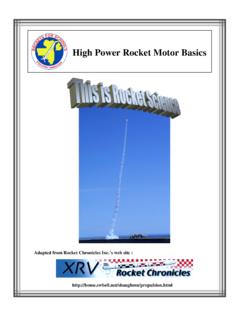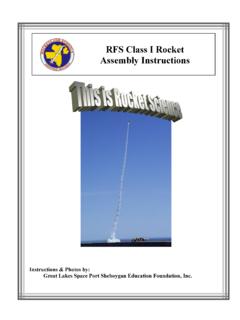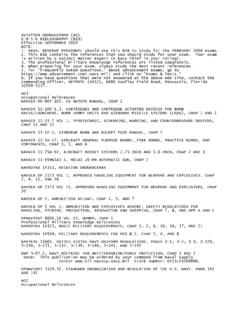Transcription of Forces on a Model Rocket - Rockets for Schools
1 Forces on a Model Rocket This pamphlet was developed using information for the Glenn Learning Technologies Project. For more information, visit their web site at: Flying Model Rockets is a relatively inexpensive way for students to learn the basics of aerodynamic Forces and the response of vehicles to external Forces . Like an aircraft, a Model Rocket is subjected to the Forces of weight, thrust, drag, and lift. There are, however, some important differences in the actions of these Forces on a Model Rocket as opposed to a powered aircraft or a glider: 1.
2 On an airplane, most of the aerodynamic Forces are generated by the wings and the tail surfaces. For a Model Rocket , the aerodynamic Forces are generated by both the body and the fins. For both aircraft and Model Rocket , the aerodynamic Forces act through the center of pressure (the yellow dot with the black center on the figure). 2. On an airplane, the lift force (the aerodynamic force perpendicular to the flight direction) is used to overcome the weight of the aircraft. On the Model Rocket , thrust is used in opposition to weight, and lift is used to stabi-lize and control the direction of flight.
3 As the Rocket is buffeted by the wind, it naturally turns back to stable flight if the center of pressure is located below the center of gravity (the plain yellow dot on the figure). 3. While most aircraft have a high lift to drag ratio, the drag of a Model Rocket is usually much higher than the lift. 4. While the magnitude and direction of the Forces remain fairly constant for an aircraft, the magnitude and direc-tion of the Forces acting on a Model Rocket change dramatically during a typical flight. Separate slides show the Forces acting on a Model Rocket during liftoff, powered flight, the coasting flight going upward and downward, and the final parachute recovery.
4 A Model Rocket rotates in flight about the center of gravity (the average location of the weight of the vehicle), just like any other flying object. It is easier to determine the center of gravity for a Model Rocket than for an aircraft. There are fewer components on a Model Rocket , and the geometry is much simpler than for an aircraft. NOTE: Modern full scale Rockets do not usually rely on aerodynamics for stability. Full scale Rockets can pivot their exhaust nozzles to provide stability and control. That's why you don't see fins on a Delta, Titan, or Atlas booster.
5 Sir Isaac Newton first presented his three laws of motion in the "Principia Mathematica Philosophiae Naturalis" in 1686. His first law states that every object will remain at rest or in uniform motion in a straight line unless com-pelled to change its state by the action of an external force . This is normally taken as the definition of inertia. The key point here is that if there is no net force acting on an object (if all the external Forces cancel each other out) then the object will maintain a constant velocity. If that velocity is zero, then the object remains at rest.
6 And if an additional external force is applied, the velocity will change because of the force . A Model Rocket lifting off from the launch pad is a good example of this principle. Just prior to engine ignition, the velocity of the Rocket is zero and the Rocket is at rest. If the Rocket is sitting on its fins, the weight of the Rocket is balanced by the re-action of the earth to the weight as described by Newton's third law of motion. There is no net force on the object, and the Rocket would remain at rest indefinitely. When the engine is ignited, the thrust of the engine creates an additional force opposed to the weight.
7 As long as the thrust is less than the weight, the combination of the thrust and the re-action force through the fins balance the weight and there is no net external force and the Rocket stays on the pad. When the thrust is equal to the weight, there is no longer any re-action force through the fins, but the net force on the Rocket is still zero. When the thrust is greater than the weight, there is a net external force equal to the thrust minus the weight, and the Rocket begins to rise. The velocity of the Rocket increases from zero to some positive value under the acceleration produced by the net external force .
8 But as the Rocket velocity increases, it encounters air resistance, or drag, which opposes the motion and increases as the square of the velocity. The thrust of the Rocket must be greater than the weight plus the drag for the Rocket to continue accelerating. If the thrust becomes equal to the weight plus the drag, the Rocket will con-tinue to climb at a fixed velocity, but it will not accelerate. On this slide, we show a schematic of a liquid Rocket engine. In a Rocket , stored fuel and stored oxidizer are pumped into a combustion chamber where they are mixed and exploded.
9 The hot exhaust is then passed through a nozzle, which accelerates the flow. The exit velocity is deter-mined by the shape of the Rocket nozzle and is supersonic. The exit pressure is set by the nozzle shape as well and will only be equal to free stream pressure at some design condition. We must, therefore, use the longer version of the thrust equation to describe the thrust of the system. If the mass flow is denoted by "m dot", the exit velocity by Ve, the pressure at the exit by pe, the free stream pressure by p0, and the nozzle exit area by Ae, the thrust (F) is given by: F = m dot * Ve + (pe - p0) * Ae This thrust equation works for both liquid and solid Rocket engines.
10 The mass flow rate through the propulsion system is determined by the nozzle design. You can explore the design and op-eration of a Rocket nozzle with our interactive nozzle simulator program which runs on your browser. Notice that there is no free stream mass times free stream velocity term in the thrust equation because no external air is brought on board. Since the oxidizer is carried on board the Rocket , Rockets can generate thrust in a vacuum where there is no other source of oxygen. That's why a Rocket will work in space, where there is no surrounding air, and a gas turbine or propel-ler will not work.











